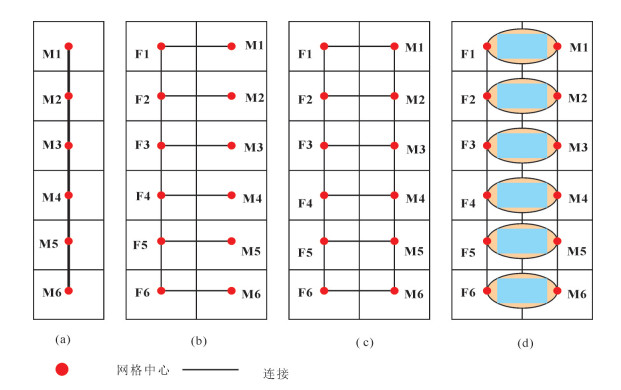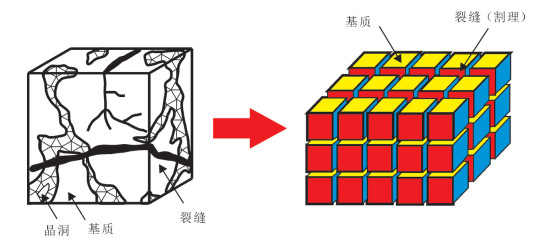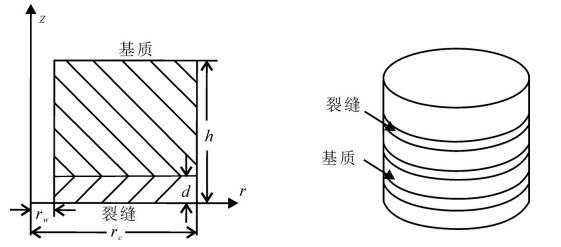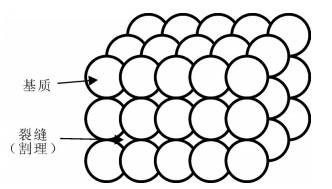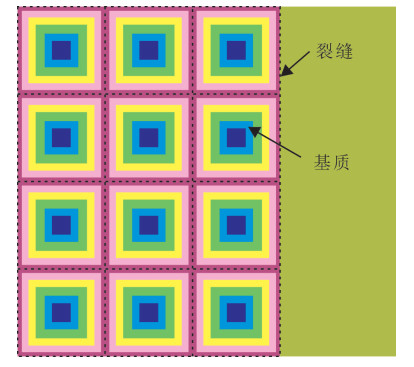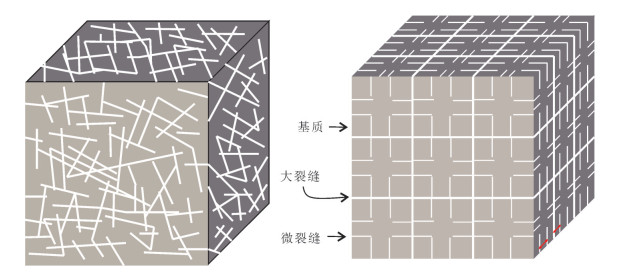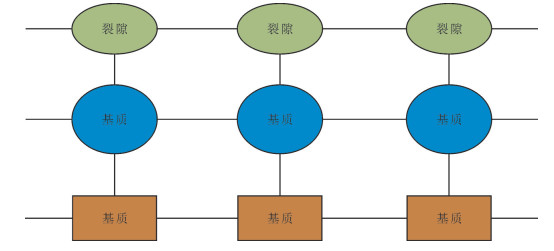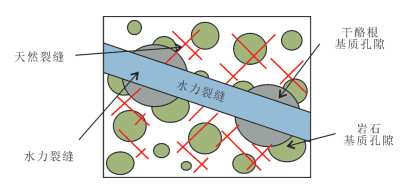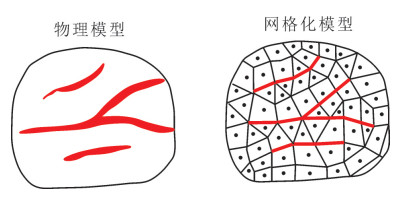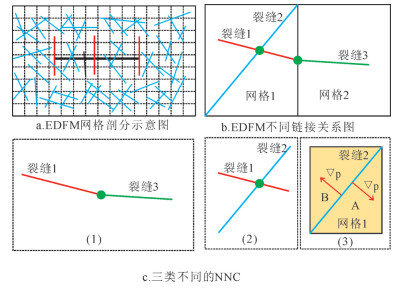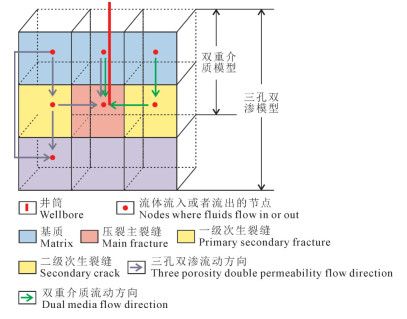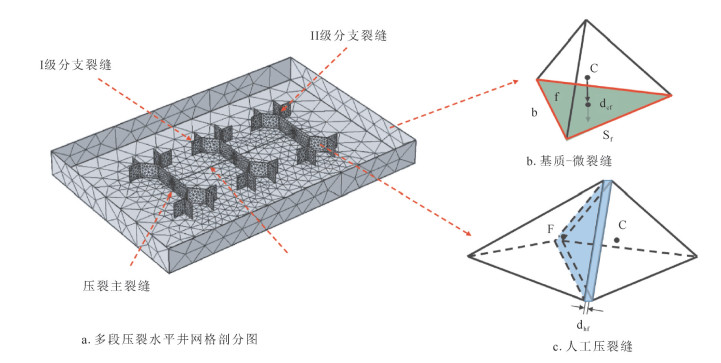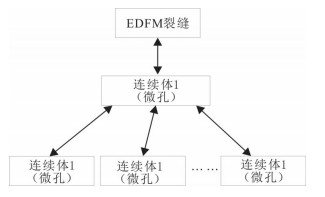-
摘要:
以页岩油气为代表的低品位油气资源勘探与开发不断取得重大突破,已经成为中国重要的接替性资源。开展页岩气渗流机理和数值模拟模型研究有助于实现页岩气藏开发的动态变化过程,为认识页岩气渗流规律、优化数学模型、产能评价和预测奠定技术基础。围绕页岩气多尺度多流态多重介质下的运移机理,系统地阐述了页岩气数值模拟模型的研究进展,页岩气数值模拟模型可分为等效连续介质模型、离散裂缝网络模型和混合模型,总结了这3类数值模拟模型的优缺点。等效连续介质模型原理简单,追求宏观尺度的等效,忽略了储层内部真实流态,适用于裂缝发育程度低的均质页岩气藏;离散裂缝网络模型准确反映复杂裂缝网络的渗流特征,可以描述高度离散裂缝的形态规律,适用于勘探程度高且裂缝高度发育的页岩气藏;混合模拟模型结合两者的优点,能够准确反映复杂裂缝网络和流体运移规律,在满足计算精度的同时又节约了大量的计算资源,随着计算处理能力的增强,混合模拟模型是今后的发展趋势。最后分析了页岩气藏数值模拟模型中存在的问题,并指出了发展方向。
Abstract:The exploration and development of low grade oil and gas resources which have become important alternative resources in China have made great breakthrough. Research on numerical simulation of shale gas is helpful to realizing the dynamic process of shale gas development, laying a technical foundation for understanding seepage law of shale gas, optimizing mathematical model and evaluating as well as predicting productivity. Based on intensive investigation of literature from China and abroad, this paper systematically expounds the research progress of numerical simulation methods of shale gas and summarizes advantages and disadvantages of these methods. Shale gas numerical simulation models can be divided into equivalent continuous medium model, discrete fracture network model and mixed simulation model. The equivalent continuum model is simple in principle, pursues the macroscopic equivalent, neglects the true flow mechanism inside the reservoir, and is hence suitable for homogeneous shale gas reservoirs with low development of fractures. The discrete fracture network model accurately can reflect the porous flow characteristics of complex fracture networks and describe the objective regularity of highly discrete fractures and is hence suitable for shale gas reservoirs with completed exploration and high fracture development. The mixed simulation model combines the advantages of these two models to accurately reflect the complex fracture network and fluid migration law, meet the calculation accuracy, and save a lot of computing resources. With the improvement of computing and processing capabilities, the mixed simulation model is the future development trend. Finally, various problems in the numerical simulation model of shale gas reservoir are analyzed, and the development trends of shale gas numerical simulation are pointed out.
-
1. 引言
在资源枯竭、经济发展和环境保护的三重压力下,寻找并开发利用新型清洁能源是关系国计民生和社会可持续发展的紧迫任务。推动绿色发展,构建清洁、安全、高效的能源体系已成为时代的要求。地热资源作为清洁能源的重要组成部分被寄予厚望。
天津市地热资源条件优越,地热开发利用水平一直处于全国前列。天津地热勘查研究工作开始于20世纪70年代,李四光同志主导的天津地热会战掀起了全国地热勘查研究的第一个春天,并发现了新近系和奥陶系两个热储。80年代以来,在市政府和原地矿部的支持以及联合国开发计划署的援助下,地热勘查开始向深部基岩热储发展,先后完成王兰庄、山岭子、塘沽地区三个地热田的勘查工作。自此之后,天津的地热研究与开发工作一直处于中国前列。先后发现地热田8个,已发现两大类6个热储,即孔隙型热储(新近系明化镇组、馆陶组热储和古近系东营组)和裂隙溶隙型热储(奥陶系、寒武系和蓟县系雾迷山组三、四段热储),3000 m以浅年可开采地热流体为7606×104 m3。其中,蓟县系雾迷山组三、四段热储是天津地热开发的主力储层。随着开发强度不断增大,部分地区开采潜力已达极限(天津地热勘查开发设计院, 2000;Wang, 2008;王继革等,2013)。
随着钻探技术的不断进步和清洁能源需求的持续增长,向地球深部进军,探测深部地热资源、开辟深部热储第二空间、增加可开采资源量,成为保障天津地区地热可持续开发的有效途径之一。为此,2017年以来,中国地质调查局在天津东丽湖地区部署了深部地热探测工作,并在主力储层下部探获雾迷山组二段高产能新储层。本文主要介绍天津东丽湖深部岩溶热储探测和高产能地热井参数研究取得的新成果、新进展。
2. 研究区概况
2.1 地热地质背景
天津市地处Ⅰ级构造单元华北地台北缘,以宁河—宝坻断裂为界分为北部山区和南部平原区。其中,南部平原区属Ⅱ级构造单元华北断坳区,是中、新生代断陷、坳陷盆地。区内Ⅲ级构造单元包括一隆两坳即沧县隆起、冀中坳陷和黄骅坳陷。隆起和坳陷及其间分布的诸多Ⅳ级构造单元凸起、凹陷的延伸方向和较大断裂的走向均呈北北东(NNE)向,形成雁行式相间排列的构造格局(陈墨香, 1988)(图 1)。
宝坻—宁河断裂以南为天津南部平原区,总面积8700 km2,地热资源条件优越。发育有王兰庄、山岭子、滨海、武清、潘庄—芦台、宁河—汉沽、万家码头和周良庄等8个地热田,年可开采地热流体7606×104 m3(图 2)。各地热田均位于华北断坳范围内,地面均为第四系松散沉积物覆盖,厚度可达数百米。其下是巨厚的新生界陆相碎屑岩沉积,是一套半胶结的砂岩和泥岩地层,沉积厚度在沧县隆起相对较薄,在冀中坳陷和黄骅坳陷沉积较厚,最大厚度可达近万米。在新生界的巨大不整合覆盖之下,主要是古生界和中上元古界的基底地层,在坳陷中还有局部中生界分布。区内地热资源主要赋存于两大类6个储层中:一类为孔隙型热储,包括新近系明化镇组、馆陶组和古近系东营组热储;一类为裂隙溶隙型热储,包括奥陶系、寒武系和蓟县系雾迷山组热储(张百鸣等, 2006; Wang, 2008)(图 3)。
东丽湖地区位于天津市东部,隶属于天津市东丽区,位于Ⅳ级构造单元潘庄凸起上,发育有著名的山岭子地热田。依据研究区内地热井的钻探资料,揭露的地层从新到老为:新生界(第四系和新近系)、古生界(奥陶系和寒武系)、中新元古界(青白口系和蓟县系)(表 1)。区内已发现新近系明化镇组、新近系馆陶组、奥陶系和蓟县系雾迷山组三、四段4个热储。其中,雾迷山组三、四段为当前主力储层,沧县隆起上钻孔揭露顶板埋深为1752~2016 m,揭露厚度为480~1032 m,单井出水量为70~120 m3/h,最大可达204 m3/h,出水温度为88~102℃,孔隙度1%~5.8%,渗透率5.52×10-14 m2,水化学类型为Cl · HCO3·SO4-Na或Cl·SO4·HCO3-Na型,总矿化度为1670~2200 mg/L,总硬度为120~240 mg/L(以CaCO3计),pH值为7.3~8.4(林黎等, 2007; 王继革等, 2013)。从区域地质资料看(高昌,2003;赵苏民等, 2006),区内雾迷山组厚度约3500 m,岩石组合为一套富镁碳酸盐岩,岩性主要为白云岩。燧石条带白云岩、硅质白云岩夹2~5层棕红、紫红色泥岩和页岩,可作为雾迷山组三、四段和一、二段的分界线。从岩性组合的相似性可以推测,雾迷山组一、二段可作为未来深部热储探测的重要方向,也是本次研究的重点。
表 1 天津东丽湖地区综合地层简表Table 1. The simplified table of geological strata in Donglihu area, Tianjin
2.2 开发利用现状
天津地热资源开发利用水平在全国居于较高地位,也是全国中低温地热直接利用规模最大的城市,是全国第一批“中国温泉之都”。自20世纪30年代以来,经过80多年的发展,天津地热资源开发利用从浅到深、从无序到有序、从粗放到精细,逐渐形成了规模化、产业化,在中国地热勘查开发利用史上具有举足轻重的作用。截至2017年,天津市共有地热开采井466眼,年开采总量为5181.08×104 m3,其中,蓟县系雾迷山组三、四段约占开采总量的54%。地热资源主要应用于供暖、洗浴、理疗、旅游、养殖等。其中,供暖是最主要的利用方式,占年总开采量的81.5%。建有地热供暖小区及公建项目496个,全市地热供暖总面积达3500×104 m2,占全市集中供暖面积的8%,是中国利用水热型地热资源供暖规模最大的城市。
东丽湖地区现有地热井34眼。其中,新近系明化镇组4眼,新近系馆陶组2眼,奥陶系3眼,蓟县系雾迷山组三、四段25眼。年开采地热流体约395.44×104 m3,采用梯级、综合利用和群井联动回灌的开发模式,达到资源的优化配置和实时调控,地热利用率和回灌率达到95%以上,实现了资源的统一规划、统一开发和统一管理。地热资源广泛应用于供暖、温泉洗浴、养生理疗、康乐旅游、矿泉水开发等领域,建有东丽湖温泉旅游度假区,在发展温泉旅游产业,促进地区经济发展,保护生态环境方面取得了显著的成效。2008年12月25日和2011年12月30日,分别被中国矿业联合会和国土资源部命名为“中国温泉之乡”。
3. 深部热储探测方法
本次研究主要基于地质综合分析,采用地球物理探测、地热钻探、地球物理测井和热储试验相结合的方法开展探测研究。
3.1 地球物理探测
为满足深部储层探测需要,本次地球物理探测的主要目标确定为5 km以浅地层的结构探测,为地热钻探提供依据。由于探测深度大,且存在高压线、铁路等城市干扰源,本次地球物理探测采用了二维地震和时频电磁相结合的勘查方法,其中,时频电磁方法首次应用到地热勘查领域。时频电磁方法是通过大功率人工场源激发信号,测量研究区测线的电磁场分量,分析频率域信号的振幅和相位特征,来获得介质的地电参数(电阻率和极化率),把信号转换到时间域,建立高分辨的电法勘探的时间断面。较传统电磁方法,在应对强电磁干扰方面具有一定的优势(Dong et al., 2008; 周印明等, 2013, 2015)。
本次工作部署时频电磁法完成测线4条,剖面24.4 km,点距200 m,物理点128个;二维地震完成剖面3条,8.25 km,测点254个(图 4)。
地球物理探测结果初步揭示了天津东丽湖地区雾迷山组二段的分布。从TFEM-1测线地质剖面解译图(图 5)可以看出,F1沧东断裂西侧,电阻率异常特征从上至下依次为“低—高—低—高—次高—高”,表层低阻和浅层高、低阻分别是第四系、新近系明化镇组与馆陶组地层响应特征,电阻率过渡连续,无明显的错断。第二套高阻层为寒武系(Є) 与青白口系(Qb)的反映,深部的次高阻为蓟县系雾迷山组4段(Jxw4)的反映,深部的高阻为蓟县系雾迷山组2、3段(Jxw2-3)的反映。蓟县系雾迷山组四段埋深2300~3000 m,下部发育雾迷山组二段和三段地层,埋深在3000 m以下。因缺乏雾迷山组二、三段电性参数,不易进一步细分。从二维地震DZ01剖面解释图(图 6)可以看出,区内4000 m以浅揭示的地层分别为第四系、新近系明化镇组、新近系馆陶组、寒武系、青白口系和蓟县系雾迷山组。新近系馆陶组底界以上主要标准反射界面清晰可辨,以下反射界面呈断续分布。推测第四系底界埋深341~363 m;新近系明化镇组底界埋深1123~1160 m,馆陶组底界埋深1347~1500 m;寒武系张夏组底界埋深1758~2033 m,馒头组底界埋深1786~2113 m,昌平组底界埋深1856~2164 m;青白口系底界埋深2196~2444 m;蓟县系雾迷山组四段底界埋深2802~3004 m,三段底界二段顶界埋深3552~3726 m。4000 m探测深度范围内未揭示蓟县系雾迷山组底界。
3.2 地热科学钻探
在天津东丽湖部署地热科学钻探CGSD-01井,目标层位为蓟县系雾迷山组二段。2017年11月20日开钻,2018年11月19日完钻。成井深度4051.68 m,3715 m进入雾迷山组二段储层,是当时天津最深的地热井。
该井井身结构为三开直井。其中,护壁段(0~76 m)采用Ф660.4 mm冲击钻钻头施工,下入Ф508 mm×8.0 mm无缝套管,总长度为74.42 m。一开井段(76~1469.53 m)采用Ф444.5 mm牙轮钻头钻进,入Ф339.7 mm×J55钢级套管,长度1469.84 m。二开井段(1469.53~2262.75 m)采用Ф311.2 mm牙轮钻头钻进,下入Ф244.5 mm×10.03 mm N80钢级套管,长度866.60 m,与一开套管重叠68.12 m。三开井段(2262.75~4051.68 m)采用Ф215.9 mm牙轮钻头钻进,下入Ф177.8 mm×9.19 mm N80钢级套管,长度1939.96 m,其中实管长度为1747.23 m,花管长度为192.73 m,与二开套管重叠151.03 m。钻进过程中,开展了岩屑和岩心采集工作。1500 m以浅每5 m捞取岩屑一次,1500 m以深每2 m捞取岩屑一次,全井共计捞取岩屑样1873个。500~4051.68 m井段采取定深分段采取岩心,累计取心37回次,进尺161.25 m,长度140.78 m,采取率85%。
3.3 地球物理测井
钻井过程中,对地热井开展了综合地球物理测井工作,主要包括温度测井、压力测井、井径测井、井斜测井、视电阻率测井、双感应测井、自然电位测井、自然伽马测井、声波测井、伽马-伽马测井和流体流量测井11项。
3.4 热储试验
钻探完成后,为获取蓟县系雾迷山组二段新储层热储参数,对地热井开展了3个落程的稳定流降压抽水试验。其中,大落程试验历时62 h,涌水量130.2 m3/h,水温度稳定在100℃,稳定时间39.5 h;中落程试验历时24 h,涌水量94.5 m3/h,水温度稳定在100℃,稳定时间16.5 h;小落程试验历时16 h,涌水量43.9 m3/h,水温度稳定在98℃,稳定时间8 h(图 7)。
4. 结果与讨论
4.1 热储结构特征
综合全井段地球物理测井、岩心与岩屑及区域地热地质等资料,CGSD-01井钻遇地层包括:第四系、新近系、寒武系、青白口系及蓟县系。钻遇主要储层5个,主要包括新近系明化镇组、馆陶组2个砂岩热储,寒武系昌平组灰岩热储,蓟县系雾迷山组三四段和一二段白云岩热储(表 2)。
表 2 天津东丽湖CGSD-01井钻遇地层表Table 2. Geological stratum of well CGSD-01 in the Tianjin
本次研究在地热井中实现雾迷山组四、三、二段精细划分,自上而下叙述如下。
雾迷山组四段(Jxw4):深度段为2258~2896 m,地层厚度638 m。上部岩性主要为浅灰色细晶白云岩夹灰黑色泥晶白云岩,偶见少量深灰色厚层角砾状白云岩、灰白色硅质白云岩等;下部岩性主要为浅灰色细晶白云岩与灰黑色泥晶白云岩、泥质白云岩交互;底部主要发育灰黑色白云质泥岩夹细晶白云岩、泥晶白云岩、硅质白云岩。受原始沉积及沉积后多期次构造与岩溶作用等影响,雾迷山组四段白云岩层系整体较破碎,钻井岩心中裂隙和溶蚀孔洞极其发育,为地热水提供了良好的储集空间。
雾迷山组三段(Jxw3):深度段为2896~3715 m,地层厚度819 m。上部岩性主要为深灰色细晶白云岩与灰黑色泥晶白云岩、泥质白云岩、白云质泥岩交互。电测曲线上,雾迷山组三段上部的GR值较雾迷山组四段底部低为特征,测井解释的泥质含量值也表现出类似特征;雾迷山组三段测井资料解释的孔隙度和渗透率值,下部整体较上部好(图 8);下部岩性主要发育浅灰—灰黑色细晶白云岩夹灰黑色泥晶—泥质白云岩、灰质泥晶白云岩及白云质泥岩;底部以发育一套紫红色泥质白云岩夹浅灰色细晶白云岩为典型特征,厚度约73 m,裂隙不发育,具有隔水—弱透水性质,作为与下伏雾迷山组二段的分界。
雾迷山组二段(Jxw2)深度段为3715~4051 m,地层厚度336 m,未钻穿。与上覆雾迷山组三段相比,雾迷山组二段的岩性及电测特征存在明显的差别(图 8)。岩性特征上,雾迷山组二段上部主要发育浅灰色细晶白云岩夹浅灰色粉晶白云岩、灰黑色泥质白云岩,之上为雾迷山组三段底部紫红色泥质白云岩作为两者明显分界;雾迷山组二段下部主要为浅灰色粉晶白云岩与灰黑色泥质白云岩交互。电测曲线上,雾迷山组二段上部的GR值、自然电位值(SP)较雾迷山组三段底部低为特征,测井解释的泥质含量值也体现出类似特征;雾迷山组二段上部的深侧向、浅侧向电阻率较雾迷山组三段底部高为特征。雾迷山组二段内部,自下而上,GR值、自然电位值(SP)、深侧向电阻率、浅侧向电阻率及测井解释的泥质含量呈逐渐变小趋势;声波时差呈逐渐变大趋势,测井资料解释的孔隙度和渗透率呈逐渐变大趋势,指示雾迷山组二段上部的热储层较下部更为发育。
4.2 温度特征
2018年11月19日对CGSD-01井开展了稳态测温。从测温曲线(图 9)可以看出,CGSD-01井底温度105℃。井温总体呈凸型曲线特征,体现了储盖层热传导机制为总体传导型、层间对流型。总体地温梯度2.4℃/100 m。其中,0~400 m第四纪地层地温梯度最高,可达8℃/100 m;400~2300 m新近系与寒武系盖层地温梯度次之,为2.4℃/100 m;2300~3500 m雾迷山组三、四段主力储层受对流作用影响,地温梯度最小,为0.83℃/100 m;3500 m以下雾迷山组二段储层地温梯度为1.7℃/100 m,对流作用较主力储层稍弱。
岩石热物性分析表明,雾迷山组二段岩石热导率在4.33~7.96 W/(m · K)(10个样品,表 3),平均值5.66 W/(m·K),略高于雾迷山组三四段平均值4.37 W/(m·K)。
表 3 CGSD-01井雾迷山组二段热储热导率测试值Table 3. Thermal conductivity test results of Wumishan Formation section 2 in well CGSD-01
4.3 热储参数
热储参数计算主要依据降压抽水试验计算。由于地热水密度与温度具有相关性,造成观测水位不能真实地反映地热井实际水位的变化,这种现象称之为“井筒效应”。资料整理过程中,以储层中部温度102.6℃作为储层温度对试验观测数据进行校准。校正后,做出的动水位埋深曲线如图 10。
采用Dupuit公式与W.Sihart公式对试验数据进行分析计算CGSD-01井的热储参数。本次抽水试验目标热储层为蓟县系雾迷山组二段,厚度336.68 m(未穿透),根据测井数据显示,裂隙厚度为123.1 m。根据降压抽水试验数据及相关校正,地热井基本参数见表 4。计算结果见表 5。依据降压抽水试验计算结果,取三个落程试验平均值可以得出,CGSD-01井单位涌水量1.53 m3/h · m,渗透系数0.40 m/d,导水系数48.69 m2/d。
表 4 CGSD-01井热储参数计算基本参数Table 4. Reservoir parameters of well CGSD-01 表 5 CGSD-01井地热热储参数计算结果Table 5. Interpretation results of pumping test for well CGSD-01
表 5 CGSD-01井地热热储参数计算结果Table 5. Interpretation results of pumping test for well CGSD-01
4.4 水化学特征
抽水试验过程中,采集样品对雾迷山组二段地热水进行了水化学、同位素和气体成分分析。
水化学分析表明,雾迷山组二段地热水水化学类型为Cl · SO4 · HCO3-Na型,矿化度1770.0 mg/L,总硬度124.6 mg/L(以CaCO3计),pH值7.63。
结垢性和腐蚀性表明,地热水不生成碳酸钙垢,不生成硫酸钙垢,不生成硅酸盐垢,对管道及利用设施具有中等腐蚀性。
气体组分测试表明,溶解气体中以氮气和甲烷为主,分别占气体组分含量的66%和27%,还有少量乙烷、丙烷、异丁烷和异戊烷,指示储层处于还原环境。
同位素分析表明,地热水δD为-72‰~-72.7‰,δ18O为9.3‰~-9.5‰,δ13C为-3‰~-3.6‰,87Sr/86Sr为0.7113~0.7114。综合水化学和同位素特征,初步推断雾迷山组二段地热水来源于大气降水,主要发生混合、阳离子交替吸附、碳酸盐岩溶解、硫酸盐还原等作用,且未达到平衡。
4.5 开发利用潜力分析与建议
从区域地质背景和地层沉积序列看,雾迷山二段热储在潘庄凸起区全区均有分布,分布面积约604 km2,依据CGSD-01地热参数井信息,对潘庄凸起雾迷山组二段热储热量进行保守估算。年可开采热资源量按照100 a富水段可回收热量的0.01% 进行保守估算,其热量每年折合标煤250万t,初步估计可满足供暖面积6114×104 m2。
为了提高地热资源利用率,本文建议推广地热利用集约节约新技术,采用地热梯级利用联合水源热泵、地板辐射采暖、群井联动、地热与燃气或太阳能等多能源结合技术,降低尾水排放温度,实现地热资源利用最大化。
5. 结论
(1) 综合全井段地球物理测井、岩心与岩屑及区域地热地质等资料,CGSD-01井钻遇主要储层5个,主要包括新近系明化镇组、馆陶组2个砂岩热储,寒武系昌平组灰岩热储,蓟县系雾迷山组三四段和一二段白云岩热储。
(2) 雾迷山组二段上部单位涌水量1.53 m3/h · m,渗透系数0.40 m/d,导水系数48.69 m2/d,岩石热导率5.66 W/(m · K),地热水类型为Cl · SO4 · HCO3-Na型,矿化度1.7 g/L,热储参数与潘庄凸起三、四段热储相近。
(3) CGSD-01井降压抽水试验结果表明,蓟县系雾迷山组二段单井最大涌水量可达130 m3/h,出水温度100 ℃,单井可满足约30万m2建筑物供暖需求;初步估计潘庄凸起雾迷山组二段热储热量可满足供暖面积6114×104 m2。
(4) 从区域地层沉积规律看,天津地区深部雾迷山组一段、杨庄组、高于庄组,厚度大、岩溶发育,与雾迷山组四、三、二段性质相似,均具有成为高产能新储层的可能性,加强深部地热探测研究意义重大。
致谢: 文章撰写过程中恩师王玉普院士对论文题目提出了建设性意见,指导老师李莉教授指导梳理了论文结构和内容,评审专家提出了宝贵的修改意见,在此一并表示诚挚的感谢。 -
图 1 页岩气藏等效连续介质模拟模型(据Wu et al., 2009)
Figure 1. Schematic diagram of different conceptualizations for handling fracture-matrix interactions (after Wu et al., 2009)
图 2 Warren-Root双重介质模型(据Warren et al., 1963)
Figure 2. Schematic diagram of Warren-Root dual porosity model (after Warren et al., 1963)
图 3 Kazemi层状双重介质模型(据Kazemi, 1969)
Figure 3. Schematic diagram of Kazemi laminar dual porosity model (after Kazemi, 1969)
图 4 Deswaan双重介质模型(据Deswaan et al., 1976)
Figure 4. Schematic diagram of Deswaan dual porosity model (after Deswaan et al., 1976)
图 5 多重连续介质(MINC)概念模型图(据Pruess et al., 1983)
Figure 5. Schematic diagram of MINC conceptual model (after Pruess et al., 1983)
图 6 三重介质概念模型(据Wu et al., 2009, 有改动)
Figure 6. Basic conceptualization for triple-continuum approximation of three-dimensional large-fracture, small-fracture, and rock matrix systems (modified from Wu et al., 2009)
图 7 页岩气三重介质扩散渗流模型(据程远方等, 2012)
Figure 7. Seepage mechanism of triple-continuum in shale gas reservoir (after Chen Yuanfang et al., 2012)
图 10 EDFM原理示意图(据Xu et al., 2017)
Figure 10. The working principle diagram for EDFM (after Xu et al., 2017)
图 11 三孔双渗模型与双重介质模型流动示意图(据李泽沛等, 2016)
Figure 11. Flows in triple porosity-dual permeability model and dual porosity model (after Li Zepei et al., 2016)
图 12 混合裂缝模拟模型示意图(据陈小凡等, 2018)
Figure 12. Scheme of mixed-fracture simulation model (after Chen Xiaofan et al., 2018)
表 1 页岩气数值模拟模型优缺点及适用范围
Table 1 Comparison of mathematical models in shale gas reservoir

-
Abdassah D, Ershaghi I. 1986. Triple-porosity systems for representing naturally fractured reservoirs[J]. SPE 13409. https://www.onepetro.org/journal-paper/SPE-13409-PA
Abelin H. 1986. Migration in a Single Fracture: An in Situ Experiment in A Natural Fracture[D]. DeP. of Chem. Eng. Royal Inst. of Technol., Stockholm, Sweden.
Azom P N, Javadpour F. 2012. Dual-continuum modelling of shale and tight gas reservoir[C]//Proceedings-SPE Annual Technical Conference and Exhibition. 4.10.2118/159584-MS.
Barenblatt G I, Zheltov I P, Kochina I N. 1960. Basic concept in the theory of homogeneous liquids in fissured rocks[J]. J. Appl. Math.Mech. (USSR), 24:1286-1303. doi: 10.1016/0021-8928(60)90107-6
Beskok Ali, Karniadakis George. 1999. A model for flows in channels pipes and ducts at micro and nanoscales[J]. Microscale Thermophysical Engineering, 3(3):43-77.
Bustin A M M, Bustin R M, Cui X. 2008. Importance of Fabric on the Production of Gas Shale[R]. SPE 114167-MS.
Bustin A M M, Bustin R M, Cui X. 2008. Importance of Fabric on the Production of Gas Shale[R]. SPE 114167-MS.
Carlson E S, James C M. 1991. Devonian Shale Gas Production: Mechanisms and Simple Models[R]. Journal of Petroleum Technology, 43(4), 476-482.
Carlson, E S, Mercer, J C. 1991. Devonian Shale Gas Production:Mechanisms and simple models[J]. Society of Petroleum Engineers. http://d.old.wanfangdata.com.cn/NSTLQK/NSTL_QKJJ0219277368/
Cavalcante F, Jose S D A, Xu Y F, Sepehrnoori K. 2015. Modeling fishbones using the embedded discrete fracture model formulation: Sensitivity analysis and history matching[C]//SPE Annual Technical Conference and Exhibition.
Chai Z, Yan B, Killough J E, Wang Y. 2018. An efficient method for fractured shale reservoir history matching: The embedded discrete fracture multi-continuum approach[C]//SPE Annual Technical Conference and Exhibition.
Chen Xianglin, Bao Shujing, Zhai Gangyi, Zhai Gangyi, Zhou Zhi, Tong Chuanchuan, Wang Chao. 2018. The discovery of shale gas within Lower Cambrian marine facies at Shan Nandi-1 well on the margin of Hannan palaeouplift[J]. Geology in China, 45(2):412-413(in Chinese with English abstract). http://d.old.wanfangdata.com.cn/Periodical/zgdizhi201802017
Chen Xiaofan, Tang Chao, Du Zhimin, Tang Liandong, Wei Jiabao, Ma Xu. 2018. Numerical simulation on multi-stage fractured horizontal wells in shale gas reservoirs based on the finite volume method[J]. Natural Gas Industry, 38(12):77-86(in Chinese with English abstract). http://d.old.wanfangdata.com.cn/Periodical/trqgy201812009
Cheng Handing, Cai Junrui, Li Yameng. 2007. Brief overview on solute transport in fractured rock masses[J]. Water Resources and Power, 25(3):33-37(in Chinese with English abstract). http://www.wanfangdata.com.cn/details/detail.do?_type=perio&id=sdnykx200703010
Cheng Yuanfang, Dong Bingxiang, Shi Xian, Li Na, Yuan Zheng. 2012. Seepage mechanism of a triple-porosity/dual-permeability model for shale gas reservoirs[J]. Natural Gas Industry, 32(9):44-47(in Chinese with English abstract).
Cipolla C L, Lolon E P, Mayerhofer M J, Mayerhofer. 2009. Fracture Design Consideration in Horizontal Wells Drilled in Unconventional Gas Reservoirs[R]. SPE 119366-MS.
Cipolla C L, Lolon E P. 2009. Reservoir Modeling and Production Evaluation in Shale Gas Reservoirs[R]. SPE 13185-MS.
Civan F, Rai C, Sondergeld C H. 2012. Determining shale permeability to gas by simultaneous analysis of various pressure tests[J]. SPE Journal, 17(1):717-726. http://www.wanfangdata.com.cn/details/detail.do?_type=perio&id=6a19e09fbe6b9cf2ab58f4a772ef3543
Civan Farukrai. 2010. Effective correlation of apparent gas permeability in tight porous media[J]. Transport in Porous Media, 82(1):375-384. doi: 10.1007%2Fs11242-009-9432-z
Cominelli A, Panfili P, Scotti A, Milano. 2013. Using embedded discrete fracture models (EDFMs) to simulate realistic fluid flow problems[C]//Second Workshop on Naturally Fractured Reservoirs: Naturally Fractured Reservoirs in Real Life.
Cominelli A, Panfili P. 2014. Simulation of miscible gas injection in a fractured carbonate reservoir using an embedded discrete fracture model[C]//Abu Dhabi International Petroleum Exhibition and Conference.
Cominelli, Alberto, Panfili P, Scotti, Anna, Milano. 2013. Using Embedded Discrete Fracture Models (EDFMs) to Simulate Realistic Fluid Flow Problems[C]//2nd EAGE Workshop Naturally Fractured Reservoirs: Naturally Fractured Reservoirs in Real Life.
Dershowitz W S, Einstein H H. 1987. Three-dimensional flow modelling in jointed rock masses[C]//Herget, Vongpaisal, editors.Proceedings of the Sixth Cong. ISRM, vol. 1. Montreal, Canada, 87-92.
Deswaan O A. 1976. Analytic solutions for determining naturally fractured reservoir properties by well testing[C]//SPE 5346.
Fang Wenchao, Jiang Hanqiao, Li Junjian, Wang Qing, Killough John, Li Linkai, Peng Yongcan, Yang Hanxu. 2017. A numerical simulation model for multi-scale flow in tight oil reservoirs[J]. Petroleum Exploration and Development, 44(3):415-422(in Chinese with English abstract). http://www.wanfangdata.com.cn/details/detail.do?_type=perio&id=syktykf201703011
Gao Shusheng, Liu Huaxun, Ye Liyou, Hu Zhiming, Chang Jin, An Weiguo. 2017. A coupling model for gas diffusion and seepage in SRV section of shale gas reservoirs[J]. Natural Gas Industry, 37(1):97-103(in Chinese with English abstract). http://www.wanfangdata.com.cn/details/detail.do?_type=perio&id=trqgy201701012
Ge Mingna, Bao Shujing, He Wei, Chen Xianglin, Lin Tuo, Chen Ke. 2018. The discovery of shale gas in Lower Cambrian marine shale gas at Huangdi-1 well in Huangping region of northern Guizhou[J]. Geology in China, 45(4):851-852(in Chinese with English abstract). http://www.wanfangdata.com.cn/details/detail.do?_type=perio&id=zgdizhi201804016
Hoteit H, Firoozabadi A. 2006. Compositional modeling of discretefractured media without transfer functions by the discontinuous galerkin and mixed methods[J]. SPE Journal, 11(3):341-352. doi: 10.2118/90277-PA
Hugo Araujo, Pablo Lacentre, Tomas Zapata. 2004. Dynamic behavior of discrete fracture network models. The 2004 SPE International Petroleum Conference[C]//Puebla, Mexico: SPE 91940.
Jack H, Norbeck, Mark W. McClure, Jonathan W. Lo, Raland N.Horne. 2015. An embedded fracture modeling framework for simulation of hydraulic fracturing and shear stimulation[J]. Computational Geosciences, 20(1):1-18. http://www.wanfangdata.com.cn/details/detail.do?_type=perio&id=94aed4d5960670ce352babe0efe0228d
James R Glman, Hossein Kazemi. 1982. Improvements in simulation of naturally fractured Reservoirs[C]//SPE 10511.
Javadpour F. 2009. Nanopores and apparent permeability of gas flow in mudrocks(Shales and Siltstone)[J]. Petroleum Society of Canada, 48(8):16-21. http://www.wanfangdata.com.cn/details/detail.do?_type=perio&id=ec81e94c9fee0298eb521b2779a59a95
Javadpour F, Fisher D, Unsworth M. 2007. Nanoscale gas flow in shale gas sediments[J]. Journal of Canadian Petroleum Technology, 46(10):55-61. http://www.wanfangdata.com.cn/details/detail.do?_type=perio&id=464138fa91f96656ef74df2d4d7931eb
Jiang J, Younis R. 2016. Hybrid coupled discrete-fracture/matrix and multicontinuum models for unconventional-reservoir simulation[J]. SPE Journal, 20(3):1009-1027. https://www.onepetro.org/journal-paper/SPE-178430-PA
Kazemi H, Seth M S, Thomas G W. 1969. Pressure transient analysis of naturally fractured reservoir with uniform fracture distribution[C]//SPE 2153.
Klimkowski L, Nagy S. 2014. Key factors in shale gas modeling and simulation[J]. Archives of Mining Sciences, 59(4):987-1004. doi: 10.2478/amsc-2014-0068
Li Bo. 2018. Numerical Study of Multiple-stage Fractured Horizontal Well in Tight Oil Reservoirs Based on Embedded Discrete Fracture Model[D]. Southwest Petroleum University Master's thesis, 1-121.
Li Zepei, Peng Xiaolong, Wang Yi. 2016. Numerical simulation method of shale gas reservoirs after stimulated reservoir volume fracturing based on triple porous media model[J]. Petroleum Geology and Recovery Efficiency, 23 (6):105-111(in Chinese with English abstract). http://www.wanfangdata.com.cn/details/detail.do?_type=perio&id=yqdzycsl201606018
Li Zhiping, Li Zhifeng. 2012. Dynamic characteristics of shale gas flow in nanoscale pores[J]. Natural Gas Industry, 32(4):50-53(in Chinese with English abstract). https://www.scientific.net/AMR.524-527.1266
Lian Peiqing, Duan Taizhong.2018. Research progress on flow characteristic and numerical simulation of shale gas reservoir[J]. Advances in Fine Petrochemicals, 19 (4):6-11, 15(in Chinese with English abstract). http://d.old.wanfangdata.com.cn/Periodical/jxsyhgjz201804003
Liang Bin, Jiang Hanqiao, Li Junjian, Mi Lidong, Wang Lei. 2015.Calculation model of multi-factor shale gas adsorption Capacity[J]. Special Oil and Gas Reservoirs, 22(1):121-123, 157(in Chinese with English abstract).
Liu, Cigun. 1982. The unsteady radial flow- of compressible liquids through a medium with multiple porosity[C]//SPE 10580.
Long J C S, Witherspoon P A. 1985. The relationship of the degree of interconneetion to permeability in fractured networks[J]. Journal of Geophysical Research, 90(134):3087-3098. doi: 10.1029/JB090iB04p03087#references-section
Louis C, Wittke W. 1971. Experimental study of water flow in jointed rock massif[J]. Tachien Project Formosa. Geotechnique, 21 (1):29-35.
Lü Xinrui, Yao Jun, Huang Zhaoqin, Zhao Juan. 2012. Study on discrete fracture model two-phase flow simulation based on finite volume method[J]. Journal of Southwest Petroleum University:Science & Technology Edition, 34(6):123-130(in Chinese with English abstract).
Ma Yongsheng, Cai Xunyu, Zhao Peirong. 2018. China's shale gas exploration and development:Understanding and practice[J]. Petroleum Exploration and Development, 45(4):561-574(in Chinese with English abstract). http://d.old.wanfangdata.com.cn/Periodical/syktykf201804003
Meng Fanyang, Chen Ke, Bao Shujing, Lin Tuo, Zhang Rui, Dong Zhoubin. 2017. Determination of marine-continental transitional facies shale gas:A case study of Baye No. 1 well in Badong area, western Hubei Province[J]. Geology in China, 44(2):403-404(in Chinese with English abstract).
Mi Lidong, Jiang Hanqiao, Hu Xiangyang, Li Junjian, Jia Ying.2018.Evaluation and selection of numerical simulation methods for shale gas reservoirs[J]. Scientia Sinica Tech., 48(6):680-690(in Chinese with English abstract). doi: 10.1360/N092017-00152
Mi Lidong, Jiang Hanqiao, Li Junjian. 2014. Investigation of shale gas numerical simulation method based on discrete fracture network model[J]. Natural Gas Geoscience, 25(11):1795-1803(in Chinese with English abstract). http://d.old.wanfangdata.com.cn/Periodical/trqdqkx201411013
Mirzaei M, Cipolla C L. 2012. A workflow for modeling and simulation of hydraulic fractures in unconventional gas reservoirs[C]//Paper 153022-MS presented at the SPE Middle East Unconventional Gas Conference and Exhibition, 23-25 January, Abu Dhabi, UAE.
Moinfar A, Narr W, Hui M H, Mallison B T, Lee S H. 2011.Comparison of discrete-fracture and dual-permeability models for multiphase flow in naturally fractured reservoirs[C]//Paper 142295-MS presented at the SPE Reservoir Simulation Symposium, 21-23 February, The Woodlands, Texas, USA.
Moinfar A, Varavei A, Sepehrnoori K, Johns R T. 2013. Development of a coupled dual continuum and discrete fracture model for the simulation of unconventional reservoirs[C]. SPE 163647.
Moinfar A, Varavei A, Sepehrnoori K. 2014. Development of an efficient embedded discrete fracture model for 3D compositional reservoir simulation in fractured reservoirs[J]. SPE Journal, 19(2):289-303. doi: 10.2118/154246-PA
Monteagudo J E P, Firoozabadi A. 2004. Numerical simulation of water injection in disconnected and connected fractured media using jacobian-free fully implicit control volume method. The 2004 SPE/DOE 14the Symposium on Improved Oil Recovery[C]//Tulsa, Oklahoma, USA. SPE 89449.
Moridis, G J, Blasingame T A, Freeman C M. 2010. Analysis of Mechanisms of Flow in Fractured Tight-Gas and Shale-Gas Reservoirs[C]//SPE 139250, presented at the SPE Latin American & Caribbean Petroleum Engineering Conference held in Lima, Peru, 1-3 December.
National Research Council. 1996. Rock Fractures and Fluid Flow: Contemporary Understanding and Applications[M]. Washington: National Academy Press.
Ozkan E, Raghavan R. 2009. Modeling of Fluid Transfer from Shale Matrix to Fracture Network[R]. SPE 134830-MS.
Passey Q R, Bohacs K M, Esch W L, Klimentidis R, Sinha S. 2010.From oil-prone source rock to gas-producing shale reservoirgeological and petrophysical characterization of unconventional shale gas reservoirs from oil-prone source rock to gas-producing shale reservoir-geological and petrophysical characterization of unconventional shale-gas reservoirs[C]//SPE 131350.
Peng Kai, Ning Zhengfu, Wang Guili. 2012. Study for flow model in dual-porosity of shale gas reservoirs[J]. Journal of Chongqing University of Science and Technology (Natural Sciences Edition), 14(1):8-11, 22(in Chinese with English abstract). http://en.cnki.com.cn/Article_en/CJFDTOTAL-CQSG201201004.htm
Pruess K. 2008. GMINC-A mesh generator for flow simulations in fractured reservoirs[J]. Lawrence Berkeley Laboratory.
Ren Lan, Lin Ran, Zhao Jinzhou, Rong Mang, Chen Jianda.2018. A stimulated reservoir volume (SRV) evaluation model and its application to shale gas well productivity enhancement[J]. Natural Gas Industry, 38(8):47-56(in Chinese with English abstract). http://d.old.wanfangdata.com.cn/Periodical/trqgy201808007
Rubin B. 2010. Accurate simulation of non-darcy flow in stimulated fractured shale reservoirs[C]//Paper 132093-MS presented at the SPE Western Meeting, Anaheim, California, USA.
Sangnimnuan A, Li J W, Wu K. 2018. Development of efficiently coupled fluid flow and geomechanics model for refracturing optimization in highly fractured reservoirs[C]//SPE Hydraulic Fracturing Technology Conference and Exhibition.
Saputelli L, Lopez C, Chacon A, Soliman M. 2014. Design optimization of horizontal wells with multiple hydraulic fractures in the Bakken Shale[C]//SPE/EAGE European Unconventional Resources Conference and Exhibition, 25-27 February, Vienna, Austria.
Snow D T. 1965. A Parallel Plate Model of Fracture Permeable Media[D]. Berkeley: Univ. of California.
Snow D T.1968. Fracture deformation and changes of permeability and storage upon changes of fluid pressure quart[J]. Colorado School of Mines, 63(1):201-244.
Song Teng, Chen Ke, Bao Shujing, Guo Tianxu, Lei Yuxue, Wang Yi, Meng Fanyang, Wang Peng.2018. The discovery of shale gas in Wufeng-Longmaxi Formation at Hongdi-1 Well on the northern limb of Shennongjia anticline in northwestern Hubei Province[J]. Geology in China, 45(1):195-196(in Chinese with English abstract). http://www.wanfangdata.com.cn/details/detail.do?_type=perio&id=zgdizhi201801017
Song Xiaochen, Xu Weiya.2004. A study on conceptual models of fluid flow in fractured rock[J]. Rock and Soil Mechanics, (2):226-232 (in Chinese with English abstract). http://en.cnki.com.cn/Article_en/CJFDTOTAL-YTLX200402015.htm
Swami Vivek, Settari A. 2012. A pore scale gas flow model for shale gas reservoir[C]//SPE Americas Unconventional Resources Conferences, Pittsburgh, Pennsylvania: Society of Petroleum Engineers, 1-10.
Swani Vivek, clarkson C R, Settari A. 2012. Non-darcy flow in shale nanopores do we have a final answer[C]//SPE162665: 1-14.
Teng Bailu, Cheng Linsong, Huang Shijun, Jia Zhen, Ai Shuang. 2016.Prediction of the drainage volume of shale gas reservoir with fast marching method[J]. Journal of Southwest Petroleum University(Science & Technology Edition), 38(2):122-128(in Chinese with English abstract).
Van Kruysdijk C P J W, Dullaert G M. 1989. A boundary element solution of the transient pressure response of multiple fractured horizontal wells[C]//Presented at the 2nd European Conference on the Mathematics of Oil Recovery, Cambridge, England.
Wang F P, Reed R M. 2009. Pore networks and fluid flow in gas shales[C]//Anon.Paper SPE124253. SPE Annual Technical Conference and Exhibition. New Orleans, Louisiana, USA.
Warpinski, N R, M J Mayerhofer, M C Vincent, C L Cipolla, E P Lolon. 2008. Stimulating unconventional reservoirs: maximizing network growth while optimizing fracture conductivity[C]//2008 SPE Shale Gas Production Conference, Fort Worth, Texas, 16-18 November.
Warren J E, Root P J.1963. The behavior of naturally fracture reservoirs[J]. Society of Petroleum Engineering Journal, (3):245-255. http://d.old.wanfangdata.com.cn/OAPaper/oai_doaj-articles_69b9c572f99bea4c3ca72e88a1763582
Watson A T, Iii J M G, Lee W J, Rahim Z. 1990. An Analytical Model for History Matching Naturally Fractured Reservoir Production Data[R]. SPE Reservoir Engineering, 5(3), 384-388.
Wei Pengyun, Shi Anfeng, Wang Xiaohong, Zhou Fangqi. 2015. A discrete fracture-dual porosity coupling model for shale gas reservoirs[J]. Chinese Quarterly of Mechanics, 36(2):179-188(in Chinese with English abstract).
Wei Shiming, Xia Yang, Jin Yan, Chen Mian, Lu Yuanhu.2019. Study on the 3D fluid-solid coupling model with multi-pressure system of shale[J]. Scientia Sinica(Physica, Mechanica & Astronomica), 49(1):40-52(in Chinese with English abstract). doi: 10.1360/SSPMA2018-00278?slug=fulltext
Wilson C R, Witherspoon P A. 1974. Steady state flow in rigid networks of fractures[J]. Water Resources Research, 10(2):328-339. doi: 10.1029-WR010i002p00328/
Wu Y S, Moridis G, Berkeley L, Bai B, Zhang K.2009. A multicontinuum model for gas production in tight fractured reservoirs[C]//SPE 118944. SPE Hydraulic Fracturing Technology Conference. Society of Petroleum Engineers.
Wu Y S, Wang C, Li J, Fackahroenphol P. 2012. Transient gas flow in unconventional gas reservoirs[C]//SPE154448, The EAGE Annual Conference & Exhibition incorporating SPE Europec held in Copenhagen, Denmark.
Xia Daoying. 2018. Study on the Model of Fluid-solid Coupling of the Numerical Simulation on Shale Gas Reservoirs[D]. Xi'an: Xi'an Shiyou University.
Xu Y, Yu W, Sepehmoori K. 2017. Modeling dynamic behaviors of complex fractures in conventional reservoir simulators[C]//Unconventional Resources Technology Conference.
Yao Jun, Sun Hai, Fan Dongyan, Huang Zhaoqin, Sun Zhixue, Zhang Guohao. 2013.Transport mechanisms and numerical simulation of shale gas reservoirs[J]. Journal of China University of Petroleum(Natural Sciences Edition), 37(1):91-98(in Chinese with English abstract).
Yao Jun, Wang Zisheng, Zhang Yun, Huang Zhaoqin.2010. Numerical simulation method of discrete fracture network for naturally fractured reservoirs[J]. Acta Petrolei Sinica, 31(2):284-288(in Chinese with English abstract). http://en.cnki.com.cn/Article_en/CJFDTotal-SYXB201002019.htm
Zhang Liehui, Shan Baochao, Zhao Yulong, Guo Jingjing, Tang Hongming. 2017. Establishment of apparent permeability model and seepage flow model for shale reservoir[J]. Lithologic Reservoirs, 29(6):108-118(in Chinese with English abstract). http://www.wanfangdata.com.cn/details/detail.do?_type=perio&id=yxyqc201706014
Zhang Min, Yao Jun, Sun Hai, Zhao Jianlin, Fan Dongyan, Huang Zhaoqin, Wang Yueying. 2015. Triple-continuum modeling of shale gas reservoirs considering the effect of kerogen[J]. Journal of Natural Gas Science and Engineering, 24:252-263. doi: 10.1016/j.jngse.2015.03.032
Zhang X, Du C, Deimbacher F. 2009. Sensitivity studies of horizontal wells with hydraulic fractures in shale gas reservoirs[J]. IPTC 13338.
Zhao Jinzhou, Ren Lan, Shen Pin, Li Yongming.2018. Latest research progresses in network fracturing theories and technologies for shale gas reservoirs[J]. Natural Gas Industry, 38(3):1-14(in Chinese with English abstract). http://www.wanfangdata.com.cn/details/detail.do?_type=perio&id=trqgy201803001
Zhao Wenzhi, Li Jianzhong, Yang Tao, Wang Shufang, Huang Jinliang. 2016. Geological difference and its significance of marine shale gases in south China[J]. Petroleum Exploration and Development, 43(4):499-510. http://www.wanfangdata.com.cn/details/detail.do?_type=perio&id=syktykf201604001
Zhou Zhi, Bao Shujing, Chen Ke, Xu Qiufeng, Zhang Shousong, Wang Chao, Wang Peng. 2018. An important discovery of shale gas in Permian formation of Jianshi area, Hubei Province[J]. Geology in China. 45(6):1304-1305(in Chinese with English abstract). http://www.wanfangdata.com.cn/details/detail.do?_type=perio&id=zgdizhi201806020
Zhu Weiyao, Ma Qian, Deng Jia. 2014.Mathematical model and application of gas flow in nano-micron pores[J]. Journal of University of Science and Technology Beijing, 36(6):709-715(in Chinese with English abstract). http://www.wanfangdata.com.cn/details/detail.do?_type=perio&id=bjkjdxxb201406001
Zou Caineng. 2013. Unconventional Petroleum Geology[M]. Beijing:Geological Publishing House, 1-310(in Chinese).
陈相霖, 包书景, 翟刚毅, 周志, 童川川, 王超.2018.汉南古隆起周缘下寒武统(陕南地1井)发现海相页岩气[J].中国地质, 45(2):412-413. http://geochina.cgs.gov.cn/geochina/ch/reader/view_abstract.aspx?file_no=20180216&flag=1 陈小凡, 唐潮, 杜志敏, 汤连东, 魏嘉宝, 马旭. 2018.基于有限体积方法的页岩气多段压裂水平井数值模拟[J].天然气工业, 38(12):77-86. doi: 10.3787/j.issn.1000-0976.2018.12.009 程汉鼎, 柴军瑞, 李亚盟.2007.裂隙岩体溶质运移研究简述[J].水电能源科学, 25(3):33-37. doi: 10.3969/j.issn.1000-7709.2007.03.010 程远方, 董丙响, 时贤, 李娜, 袁征. 2012.页岩气藏三孔双渗模型的渗流机理[J].天然气工业, 32(9):44-47. doi: 10.3787/j.issn.1000-0976.2012.09.010 方文超, 姜汉桥, 李俊键, 王青, Kilkough John, 李林凯, 彭永灿, 杨晗旭.2017.致密储集层跨尺度耦合渗流数值模拟模型[J].石油勘探与开发, 44(3):415-422. http://d.old.wanfangdata.com.cn/Periodical/syktykf201703011 冯其红, 徐世乾, 王森, 杨毅, 高方方, 徐亚娟.2017.基于嵌入离散裂缝的页岩气藏视滲透率模型[J].地球科学, 42(8):1301-1313. http://www.wanfangdata.com.cn/details/detail.do?_type=perio&id=dqkx201708007 高树生, 刘华勋, 叶礼友, 胡志明, 常进, 安卫国.2017.页岩气藏SRV区域气体扩散与渗流耦合模型研究[J].天然气工业, 37(1):97-103. http://www.cnki.com.cn/Article/CJFDTotal-TRQG201701019.htm 葛明娜, 包书景, 何伟, 陈相霖, 林拓, 陈科.2018.黔北黄平地区黄地1井下寒武统发现海相页岩气[J].中国地质, 45(4):851-852. http://geochina.cgs.gov.cn/geochina/ch/reader/view_abstract.aspx?file_no=20180414&flag=1 姜瑞忠, 原建伟, 崔永正, 潘红, 李广, 张海涛. 2019.考虑岩石变形的页岩气藏双重介质数值模拟[J].油气地质与采收率, 26(4):70-76. http://d.old.wanfangdata.com.cn/Periodical/yqdzycsl201904010 李博. 2018.致密油藏分段压裂水平井嵌入式离散裂缝模型数值模拟研究[D].西南石油大学, 1-121. 李泽沛, 彭小龙, 王毅. 2016.基于三重介质模型的体积压裂后页岩气储层数值模拟模型[J].油气地质与采收率, 23 (6):105-111. doi: 10.3969/j.issn.1009-9603.2016.06.018 李治平, 李智锋. 2012.页岩气纳米级孔隙渗流动态特征[J].天然气工业, 32(4):50-53. doi: 10.3787/j.issn.1000-0976.2012.04.012 廉培庆, 段太忠.2018.页岩气藏渗流特征及数值模拟研究进展[J].精细石油化工进展, 19 (4):6-11, 15. doi: 10.3969/j.issn.1009-8348.2018.04.003 梁彬, 姜汉桥, 李俊键, 糜利栋, 王磊.2015.考虑多因素的页岩气吸附能力计算模型[J].特种油气藏, (1):121-123. doi: 10.3969/j.issn.1006-6535.2015.01.028 吕心瑞, 姚军, 黄朝琴, 赵娟.2012.基于有限体积法的离散裂缝模型两相流动模拟[J].西南石油大学学报(自然科学版), 34(6):123-130. http://d.old.wanfangdata.com.cn/Periodical/xnsyxyxb201206019 马永生, 蔡勋育, 赵培荣.2018.中国页岩气勘探开发理论认识与实践[J].石油勘探与开发, 45(4):561-574. http://d.old.wanfangdata.com.cn/Periodical/syktykf201804003 孟凡洋, 陈科, 包书景, 林拓, 张瑞, 董周宾. 2017.鄂西巴东地区(巴页1井)发现海陆过渡相页岩气[J].中国地质, 44(2):403-404. http://geochina.cgs.gov.cn/geochina/ch/reader/view_abstract.aspx?file_no=20170216&flag=1 糜利栋, 姜汉桥, 胡向阳, 李俊健, 贾英. 2018.页岩气藏数值模拟模型评价及选择[J].中国科学:技术科学, 48(6):680-690. 糜利栋, 姜汉桥, 李俊键. 2014.页岩气离散裂缝网络模型数值模拟模型研究[J].天然气地球科学, 25(11):1795-1803. doi: 10.11764/j.issn.1672-1926.2014.11.1795 彭凯, 宁正福, 王桂丽. 2012.页岩气藏双重介质渗流模型研究[J].重庆科技学院学报(自然科学版), 14(1):8-11, 22. doi: 10.3969/j.issn.1673-1980.2012.01.003 任岚, 林然, 赵金洲, 荣莽, 陈建达. 2018.页岩气水平井增产改造体积评价模型及其应用[J].天然气工业, 38(8):47-56. http://d.old.wanfangdata.com.cn/Periodical/trqgy201808007 宋腾, 陈科, 包书景, 郭天旭, 雷玉雪, 王亿, 孟凡洋, 王鹏. 2018.鄂西北神农架背斜北翼(鄂红地1井)五峰-龙马溪组钻获页岩气显示[J].中国地质, 45(1):195-196. http://geochina.cgs.gov.cn/geochina/ch/reader/view_abstract.aspx?file_no=20180117&flag=1 宋晓晨, 徐卫亚.2004.裂隙岩体渗流概念模型研究[J].岩土力学, (2):226-232. doi: 10.3969/j.issn.1000-7598.2004.02.013 滕柏路, 程林松, 黄世军, 贾振, 艾爽. 2016.基于波前快速推进法的页岩气储层动用预测[J].西南石油大学学报(自然科学版), 38(2):122-128. http://d.old.wanfangdata.com.cn/Periodical/xnsyxyxb201602015 韦世明, 夏阳, 金衍, 陈勉, 卢运虎. 2019.三维页岩储层多重压力流固耦合模型研究[J].中国科学:物理学力学天文学, 49(1):40-52. http://www.cnki.com.cn/Article/CJFDTotal-JGXK201901004.htm 卫鹏云, 施安峰, 王晓宏, 周方奇. 2015.页岩气藏的双重介质离散裂缝模型[J].力学季刊, 36(2):179-188. http://d.old.wanfangdata.com.cn/Conference/8681115 夏道应. 2018.页岩气藏流固耦合模型数值模拟研究[D].西安: 西安石油大学. 严侠, 黄朝琴, 姚军, 黄涛. 2014.基于模拟有限差分的嵌入式离散裂缝数学模型[J].中国科学:技术科学, 44(12):1333-1342. http://www.wanfangdata.com.cn/details/detail.do?_type=perio&id=zgkx-ce201412011 姚军, 孙海, 樊冬艳, 黄朝琴, 孙致学, 张国浩. 2013.页岩气藏运移机制及数值模拟[J].中国石油大学学报(自然科学版), 37(1):91-98 doi: 10.3969/j.issn.1673-5005.2013.01.015 姚军, 王子胜, 张允, 黄朝琴. 2010.天然裂缝性油藏的离散裂缝网络数值模拟模型[J].石油学报, 31(2):284-288. http://www.cnki.com.cn/Article/CJFDTotal-SYXB201002019.htm 张烈辉, 单保超, 赵玉龙, 郭晶晶, 唐洪明. 2017.页岩气藏表观渗透率和综合渗流模型建立[J].岩性油气藏, 29(6):108-118. doi: 10.3969/j.issn.1673-8926.2017.06.014 赵金洲, 任岚, 沈骋, 李勇明. 2018.页岩气储层缝网压裂理论与技术研究新进展[J].天然气工业, 38(3):1-14. http://www.wanfangdata.com.cn/details/detail.do?_type=perio&id=trqgy201803001 周志, 包书景, 陈科, 徐秋枫, 张守松, 王超, 王鹏. 2018.湖北建始地区二叠系鄂建业1井钻获页岩气[J].中国地质, 45(6):1304-1305. http://geochina.cgs.gov.cn/geochina/ch/reader/view_abstract.aspx?file_no=20180619&flag=1 朱维耀, 马千, 邓佳, 马东旭, 宋智勇, 岳明. 2014.纳微米级孔隙气体流动数学模型及应用[J].北京科技大学学报, 2014, 36(6):709-715. http://d.old.wanfangdata.com.cn/Periodical/bjkjdxxb201406001 邹才能. 2013.非常规油气地质学[M].北京:地质出版社, 1-310. -
期刊类型引用(7)
1. 何沛欣. 广东省粤中断裂型碳酸盐岩地热水的水文地球化学研究——以马星-隔陂地热系统为例. 广东化工. 2024(05): 67-71 .  百度学术
百度学术
2. 王君照,李胜涛,岳冬冬,张秋霞,李菊红,崔俊艳,杨骊. 基于GIS与GOCAD的天津双窑凸起构造区热储三维地质建模. 科学技术与工程. 2023(14): 5887-5902 .  百度学术
百度学术
3. 程正璞,雷鸣,李戍,连晟,魏强. 天津东丽湖深部岩溶热储时频电磁法探测及有利区预测. 华北地质. 2023(02): 1-8 .  百度学术
百度学术
4. 岳冬冬,贾小丰,张秋霞,冯昭龙,李胜涛. 天津山岭子地热田蓟县系雾迷山组热储流体同位素特征及其指示意义. 华北地质. 2023(02): 45-50 .  百度学术
百度学术
5. 刘杰,宋美钰,胥博文,阮传侠,石峰. 天津市馆陶组地热流体可采量计算方法及适宜性分区研究. 中国地质. 2023(06): 1655-1666 .  本站查看
本站查看
6. 杨吉龙,汪大明,牛文超,相振群,刘洋,赵泽霖,程先钰. 天津地热资源开发利用前景及存在问题. 华北地质. 2022(03): 1-6 .  百度学术
百度学术
7. 王婷灏,汪新伟,毛翔,罗璐,高楠安,刘慧盈,吴陈冰洁. 沧县隆起北部地区地热资源特征及开发潜力. 中国地质. 2022(06): 1747-1764 .  本站查看
本站查看
其他类型引用(2)




 下载:
下载:









